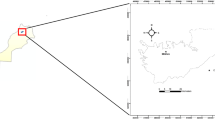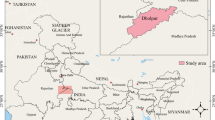Abstract
One of the most crucial design steps to guarantee the long life and the sustainability of artificial recharge of groundwater projects is to find the best locations. The present study focuses on identifying potential zones of groundwater artificial recharge in Shabestar region, northwest of Iran. For this purpose, random forest (RF) model, a learning method based on ensemble decision trees, was proposed for locating groundwater artificial recharge. Important factors, including slope and slope aspect, soil texture, erosion, land use, groundwater quality, permeability and geological lithology were integrated in a geographic information science (GIS). According to RF model, permeability and unsaturated zone thickness were identified as the most effective parameters for locating groundwater artificial recharge sites. Based on the proposed model, it was found that 14% of the region is located in suitable site for groundwater artificial recharge projects. The accuracy of the model was evaluated with receiver-operating characteristic (ROC) curve and the mean squared error (MSE). Low MSE and ROC curve of the model with the highest area under curve equal to 0.947, indicated high accuracy of random forest in locating groundwater artificial recharge.






Similar content being viewed by others
Notes
Receiver-operating characteristic.
Area under curve.
References
Balachandar D, Alaguraja P, Sundaraj P, Rutharvelmurthy K, Kumaraswamy K (2010) Application of remote sensing and GIS for artificial recharge zone in Sivaganga district, Tamilnadu, India. Int J Geomat Geosci 1(1):84
Bellman R (2003) Dynamic programming. Dover Publications, Mineola
Blum AL, Langley P (1997) Selection of relevant features and examples in machine learning. J Artif Intell 97(1–2):245–271
Booker DJ, Snelder TH (2012) Comparing methods for estimating flow duration curves at ungauged sites. J Hydrol 434–435:78–94
Bouwer H (2002) Artificial recharge of groundwater: hydrogeology and engineering. J Hydrol 10:121–142
Breiman L (1999) Random forests. UC Berkeley TR567
Breiman L (2001) Random forests. Mach Learn 45(1):5–32
Dillon P (2005) Future management of aquifer recharge. Hydrogeol J 13:313–316
Duda RO, Hart PE, Stork DG (2011) Pattern classification. Wiley, New York
Gareth J, Daniela W, Trevor H, Robert T (2013) An introduction to statistical learning: with applications in R. Springer, New York, pp 316–321
Ghayoumian J, Mohseni-Saravi M, Feiznia S, Nouri B, Malekian A (2007) Application of GIS techniques to determine areas most suitable for artificial groundwater recharge in a coastal aquifer in southern Iran. J Asian Earth Sci 30:346–374
Guyon I, Elisseeff A (2003) An introduction to variable and feature selection. J Mach Learn Res 3:1157–1182
Herrera M, Torgo L, Izquierdo J, Pérez-García R (2010) Predictive models for forecasting hourly urban water demand. J Hydrol 387(1–2):141–150
Hosseini N, Asghari MA, Nadiri A (2016) Determining vulnerable areas of Malikan plain aquifer for nitrate using random forest method. J Environ Stud 41:923–942
Huang J, Xu J, Liu X, Liu J, Wang L (2011) Spatial distribution pattern analysis of groundwater nitrate nitrogen pollution in Shandong intensive farming regions of China using neural network method. J Math Comput Model 54(3–4):995–1004
Mahdavi A, Tabatabaei SH, Mahdavi R, Nouri Emamzadei MR (2013) Application of digital techniques to identify aquifer artificial recharge sites in GIS environment. Int J Digit Earth 6(6):589–609
Mehrabi H, Zeinivand H, Hadidi M (2013) Site selection for groundwater artificial recharge in Silakhor rangelands using GIS technique. J Rangel Sci 2(4):687–695
Minnig M, Moecka Ch, Radnya D, Schirmer M (2015) Impact of urbanization on groundwater recharge rates in Dübendorf, Switzerland. J Hydrol 563:1135–1146
Mousavi A (2009) Update of quantitative model and providing quality model of shabestar plain aquifer. Dissertation, University of Tabriz (in Persian)
Oaksford ET (1985) Artificial recharge: methods, hydraulics and monitoring. In: Asano T (ed) Artificial recharge of groundwater. Butterworth, Boston, pp 69–127
Pal M (2005) Random Forest classifier for remote sensing classification. Int J Remote Sens 26(1):217–222
Peters J, De Baets B, Verhoest NE, Samson R, Degroeve S, De Becker P, Huybrechts W (2007) Random forests as a tool for ecohydrological distribution modelling. J Ecol Model 207(2–4):304–318
Quinlan JR (1990) Learning logical definitions from relations. Mach Learn 5(3):239–266
Quinlan JR (2014) C4.5: programs for machine learning. Elsevier
Riad PH, Billib M, Hassan AA, Salam MA, El Din MN (2011) Application of the overlay weighted model and Boolean logic to determine the best locations for artificial recharge of groundwater. J Urb Environ Engin 5(2):57–66
Rodriguez-Galiano VF, Ghimire B, Rogan J, Chica-Olmo M, Rigol-Sanchez JP (2012a) An assessment of the effectiveness of a random forest classifier for land-cover classification. ISPRS J Photogramm Remote Sens 67:93–104
Rodriguez-Galiano VF, Chica-Olmo M, Abarca-Hernandez F, Atkinson PM, Jeganathan C (2012b) Random forest classification of Mediterranean land cover using multi-seasonal imagery and multi-seasonal texture. Remote Sens Environ 121:93–107
Saeys Y, Inza I, Larrañaga P (2007) A review of feature selection techniques in bioinformatics. Bioinform 23(19):2507–2517
Sesnie SE, Gessler PE, Finegan B, Thessler S (2008) Integrating Landsat TM and SRTM-DEM derived variables with decision trees for habitat classification and change detection in complex neotropical environments. Remote Sens Environ 112(5):2145–2159
Shankar MR, Mohan G (2005) A GIS based hydrogeomorphic approach for identification of site-specific artificial-recharge techniques in the Deccan Volcanic Province. J Earth Syst Sci 114(5):505–514
Tiwari AK, Lavy M, Amanzio G, De Maio M, Singh PK, Mahato MK (2017) Identification of artificial groundwater recharging zone using a GIS-based fuzzy logic approach: a case study in a coal mine area of the Damodar Valley. India. Appl Water Sci 7(8):4513–4524
Zaidi FK, Nazzal Y, Ahmed I, Naeema M, Jafria MK (2015) Identification of potential artificial groundwater recharge zones in northwestern Saudi Arabia using GIS and Boolean logic. J Afr Earth Sc 111:156–169
Zhang GH, Fei YH, Xing KA (2004) A study on artificial underground reserve function in the aquifer with river channels in Taihang piedmont plain of China: a case study in the alluvial plain of Hutuo River. J Arid Land Resour Environ 18(1):42–48
Author information
Authors and Affiliations
Corresponding author
Additional information
Publisher's Note
Springer Nature remains neutral with regard to jurisdictional claims in published maps and institutional affiliations.
Rights and permissions
About this article
Cite this article
Norouzi, H., Shahmohammadi-Kalalagh, S. Locating groundwater artificial recharge sites using random forest: a case study of Shabestar region, Iran. Environ Earth Sci 78, 380 (2019). https://doi.org/10.1007/s12665-019-8381-2
Received:
Accepted:
Published:
DOI: https://doi.org/10.1007/s12665-019-8381-2




